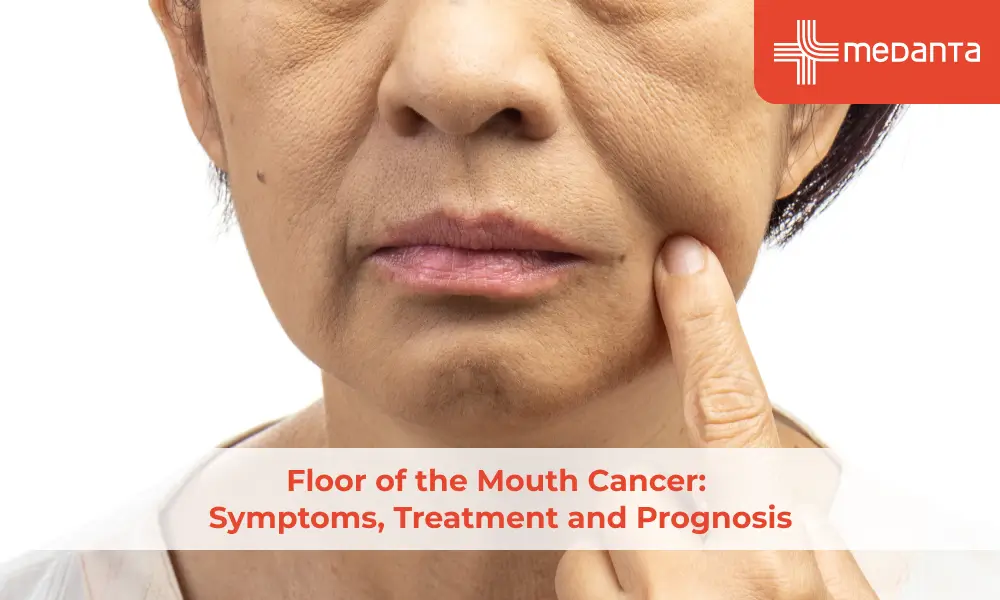Floor of the Mouth Cancer: Symptoms, Treatment and Prognosis

TABLE OF CONTENTS
Introduction
Cancer that appears in any of the components of the mouth is referred to as mouth cancer (oral cavity). Mouth cancer can develop from the following conditions in the mouth:
Lips
Gums
Tongue
The inner lining of the cheeks
The roof of the mouth
The area under the tongue of the mouth
Oral cancer and oral cavity cancer are two more names for cancer that develops on the interior of the mouth.
One of the cancers included in the head and neck cancer category is mouth cancer. Treatment for head and neck malignancies, including mouth cancer, is frequently the same.
Types of Mouth Cancer You Should Know
There are various ways in which oral cancer can progress. Your treatment and care will depend on the type of oral cancer you have. Some common types of mouth cancer include:
Squamous cell carcinoma
Minor salivary gland, such as:
Adenoid cystic carcinoma (ACC)
Mucoepidermoid carcinoma
Polymorphous low-grade adenocarcinoma
Carcinoma ex-pleomorphic adenoma
Mucosal melanoma
Sarcomas
Lymphomas
Common Areas Where Oral Cancer Can Develop
Lip: The most common location for mouth cancer is the lip. It is both skin cancer and oral cancer, however, depending on where it occurs, it is usually treated as oral cancer.
Gum and Jaw: Gum and jaw cancer can develop in the upper and lower gums and, if it advances, can infiltrate the jaw bone. Chewing tobacco usage, frequent drinking, and smoking all increase the risk of developing gum cancer. Gums may bleed, stiffen, crack, or develop sores in people with gum cancer.
Tongue: The front two-thirds of the tongue is where tongue cancer develops (the base of tongue cancer is known as oropharyngeal or throat cancer). It is well known that tongue cancer has a significant probability of migrating to the neck's lymph nodes. People might suffer bleeding, red or white patches on the tongue, pain, numbness, and difficulty during swallowing.
Buccal mucosa: Cheeks are very common sites for developing cancer. If advanced they can progress to involve facial skin.
Palate: This can be involved in patients who do reverse smoking. Also sinus tumors can progress and involve hard palate.
Symptoms and Early Signs of Mouth Cancer
Signs and symptoms of mouth cancer may include:
A mouth or lip sore that doesn't go away
A spot inside of your mouth that bleeds on touch
Loose teeth
A growth or lump inside your mouth
Mouth pain
Ear pain
Difficult or painful swallowing
Lumps in neck
Stages of Oral Cancer and Their Meaning
The Roman numbers I through IV are used to denote the stages of mouth cancer. A lesser stage, such as stage I, denotes a more localized malignancy. A higher stage, such as stage IV, denotes a more serious case of cancer or the spread of the disease to further parts of the head, neck, or body. The stage of your cancer helps your doctor decide on the best course of action.
How Is Mouth Cancer Diagnosed?
Your doctor will analyze your medical history and then conduct the following tests to identify oral cancer:
Physical Exam: Your mouth and lips will be examined by your doctor or dentist to check for any anomalies, such as irritated spots like ulcers and white patches (leukoplakia).
Removal of tissue for testing (biopsy): Your doctor or dentist may perform a biopsy if they discover a questionable spot and take a sample of cells for laboratory analysis. A sample of tissue may be taken by the doctor using a cutting instrument or a needle. The cells are examined in the lab for cancer or precancerous alterations that suggest a chance of developing cancer in the future.
Your doctor tries to assess the extent (stage) of your cancer after diagnosing it. Staging exams for oral cancer could include the following:
Examining your throat with a tiny camera: A tiny, flexible camera with a light may be sent down your throat during an endoscopic procedure by your doctor to check for indications that cancer has spread from your mouth.
Imaging tests: Several imaging procedures can be used to evaluate whether cancer has progressed outside of your mouth. X-rays, CT scans, MRIs, and positron emission tomography (PET) scans are a few examples of imaging examinations. Not everybody needs every test. Based on your health, your doctor will decide which tests are necessary.
Treatment Options Available for Mouth Cancer
Surgery, radiation therapy, and chemotherapy are the three primary forms of treatment for oral (mouth) conditions. Discuss all of your alternatives' purposes, drawbacks, and management strategies with your doctor.
Before proposing a course of therapy, your doctor takes into account several variables.
These elements consist of:
Type of oral cancer you possess.
If your oral cancer has migrated from its initial location to your neck, other regions of your mouth, or other areas of your body.
Your overall well-being.
Its age.
Alarming factors:
Dysphagia, changes in how your mouth looks, and speech issues are just a few of the side effects that oral cancer and its treatment can bring on. Sometimes these consequences might result in emotional issues and a retreat from daily life.
Conclusion:
Oral cancer is a dangerous condition that if detected early can be successfully treated. You should make an effort to visit your dentist twice a year and schedule time to perform a monthly self-exam. One of the most effective strategies to prevent oral cancer is to abstain from using tobacco products and alcohol. A cancer diagnosis can be frightening. But remember that you don't have to do it alone. Consult your medical professionals about tools to use when telling friends and family about your mouth cancer.






